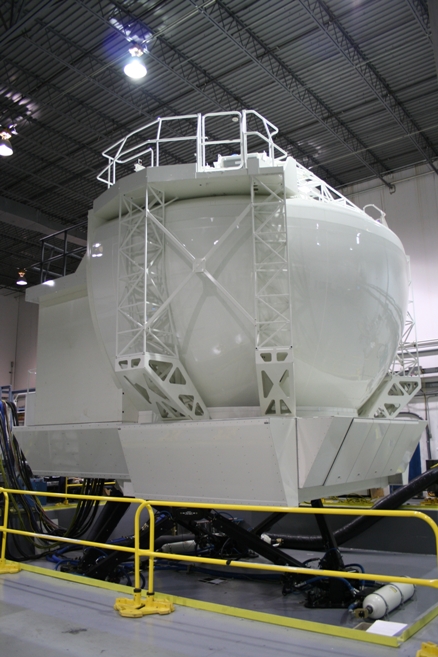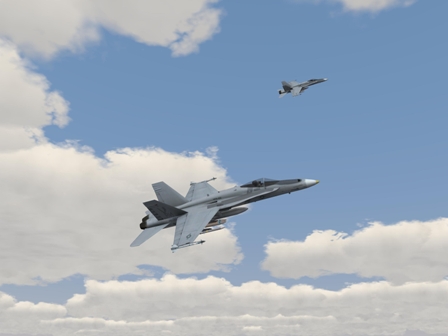This is a good time to be in the military training and simulation business. While military aircraft manufacturers are bracing themselves for a major downturn, with defence budgets expected to be slashed and new aircraft projects likely to be put on hold or cancelled, the mood in the training sector is much more positive.
Most of the leading military training and simulation suppliers have recorded impressive revenue growth over the last year and they do not expect any slowdown as their customers continue to look towards simulators as a way to reduce costs while improving the readiness of their pilots. Over the last year 62 new military simulators have been supplied, expanding the base to more than 1,500, according to the annual military simulator census compiled by Flight Insight.
For example, CAE's military training and simulation business grew by 25% in its last fiscal year according to Mark Parent, group president for simulation products and military training and services. Military sales now account for half of CAE's business, up from about a third at the beginning of the decade. "We think this year will be another good year," says Parent.
Dave Spooner, Thales director of strategy for military fixed-wing training and simulation, agrees: "2008 has turned into a very good year for the industry. We see continuing demand for military simulators."
FlightSafety vice-president simulation Rick Armstrong says the military sector "is certainly a growth segment for FlightSafety", which has always had a much stronger civilian business. "Our military business is growing faster than the market," he adds.
While much of the growth over the last year has been generated by orders for new simulators tied to the introduction of new aircraft, suppliers say they also received a significant amount of orders for additional simulators and upgrades tied to the migration of training missions from the air to the ground. The transfer of training missions to simulators has been a long-term industry trend made possible by continued improvements in simulation technology and the fact that militaries have slowly become accustomed to the concept.

Parent says the rapid increase in fuel prices in the first half of this year further accelerated this trend. While fuel prices have come down in recent months, armed forces now need to continue accelerating the migration of training missions to simulators to balance their rapidly shrinking budgets.
SIMULATOR HOURS
For example, the US Air Force wants to increase simulator hours and decrease flying hours as part of a campaign to cut costs - the USAF reports that on average six minutes in an aircraft can buy one hour in a simulator. Industry experts say for some platforms the aircraft-to-simulator hourly/cost ratio can be eight or even 10 to one and migrating training to simulators in the current economic environment simply provides a cost saving too big to pass up.
"There are not a whole lot of new acquisitions these days but I think existing programmes will expand because of the economics," says FlightSafety Defence Training Systems vice president John Marino. "The simulators in our air force programmes are very busy and if there's an increase in simulator training they will need more devices."
While the amount of training now carried out on simulators varies wildly depending on the platform and the operator, suppliers are confident that there are opportunities almost everywhere to shift more training out of the aircraft. Parent believes "there's still room to grow" the proportion of training done in a simulator by tanker, transport and bomber pilots, which in most cases is already above 50%. He adds that fighter operators are also starting to warm to the idea of transferring training to simulators something they traditionally haven't done.

Jim Scott, FlightSafety director of military business development simulation, says on average about 30% of military pilot training is now done in simulators, but the services are now trying to increase that proporton to 50%, 60% and in some cases even 70%. "They can't do that without more devices," he says.
Scott adds that the upgrade business will also remain brisk because operators need more capable simulators in order to shift more of the training syllabus to the ground: "In general the fidelity and capability of devices they have today is not what they want."
Suppliers say another driver accelerating the migration of training to simulators is the ageing fleet. Air forces, navies and armies are now being forced to look for ways to reduce the workload on their aircraft because in recent years they have clocked more hours than expected due to the high tempo of operations. By cutting back or even eliminating training missions, which typically put more stress on aircraft than other types of missions, armed forces can extend service lives and afford to wait longer for replacements. And in the current economic environment, delays in acquiring replacements are inevitable.
"We've seen orders come in to save wear and tear on aircraft and extend the useful life of aircraft," Parent says, adding that the high frequency of conflicts in recent years means wear and tear "is orders of magnitude higher" than ever before.
"More and more aircraft are operating in theatre," Spooner says. "It's a very complex environment we're operating in."
HIGH TEMPO
Yet another encouraging sign for training providers is the fact that in many cases training has been deferred due to the high tempo of operations overseas and militaries will need to catch up as forces are finally withdrawn from conflict zones. Marino says: "As Iraq draws down there's another opportunity out there to increase training."
Suppliers report environmental issues are also prompting some militaries to cut down on live training. Spooner says this is particularly becoming an issue in Europe, pointing out that there is no longer any airspace available for training in the Netherlands, while in Germany the amount of available airspace has been reduced significantly: "Military flying is getting more and more restricted each year."
For Thales, Spooner says the lack of available training space means more work for its Eurofighter Typhoon simulators: "They're all being used because it's so difficult to do live training these days."

Fortunately for operators, simulation technology has advanced to the point where training in a simulator can be as good as, and sometimes even better than, the real thing. For example, Spooner says a UK-based simulator can now accurately depict in 3D graphics weather typical of the Middle East or Far East, providing the pilot with an environment that would be impossible to duplicate in an aircraft flying in Europe. The latest simulators can also depict clear, accurate and precise images of faraway villages, simulate scenarios which are hard to create on aircraft such as jamming, and bring together pilots flying multiple types of aircraft and based in different corners of the world in one exercise. "There's a lot more capability than there even was a couple of years ago," says Scott.
Armstrong adds that at the same time the cost of devices has steadily fallen, making migration to simulators even more attractive: "Devices have become not only better - they've become cheaper."
The military training business, however, is about more than just simulators. Many suppliers now rely on services rather than products to generate half of their revenues and this side of the business is growing at least as fast.
In recent years outsourcing and privatisation of training has become more common in military circles and this trend is also expected to accelerate as budgets tighten.
"Countries, in particular in the Middle East, are talking to us about outsourcing training so they can allocate their scarce resources to weapons," says Spooner. "Training is no longer core and industry is generally more efficient at running training programmes than air forces. It's a major part of our business and we plan to expand that business." Parent agrees: "We see more opportunities in that realm. We're seeing an acceleration."
And Scott says FlightSafety also "sees a lot of opportunities" for military pilot training private finance initiatives in North America and overseas.
But while the overall pie continues to expand for both military training services and products, competition for contracts is increasing too. Suppliers say several new companies are trying to break into the market and competition between established suppliers is also heating up as many of the players which traditionally focused on one region are becoming more global in their outlook.
MARKET SHARE
For example, Spooner says Thales is now starting to focus on the US market again after largely ignoring it for 15 years. Thales has not delivered any military simulators in the USA since the early 1990s, when it delivered over 20 Boeing KC-10 and KC-135 devices to the USAF. As a result Thales' US market share has steadily fallen today less than 10% of its military training and simulation revenues are generated in North America, compared with over 80% in Europe and the Middle East.
Spooner says it is now starting to pursue business in the USA again the company hopes its long experience in the KC-10 and KC-135 programmes will "help us springboard back" into the market. "You'll see us doing a lot of activity in the USA... you can't afford to stay out of the US market, he says."
By way of contrast, FlightSafety has all but a few of its military simulators in the USA or at US bases overseas. "Our main focus is the US Air Force, army, navy and support thereof," says Armstrong. But he quickly adds that pursuing more international business "is definitely part of our strategy going forward" and "one of our future focus areas is to be involved not only in foreign military sales but in direct foreign sales".

However, diversifying and expanding outside your home territory can be difficult in the military sector. "The minute we leave our shores, life becomes more complicated," Marino points out.
Spooner believes that for many international growth markets, the best solution is to form a local joint venture and establish what Thales calls a "multi-domestic capability". He says many countries "really want to see skill stay in country" and do not want to simply import a simulator.
Earlier this year Thales forged a partnership with Saudi Arabia's Advanced Electronics to manufacture simulators for Saudi Arabian and other customers in the Middle East. Spooner claims this kind of joint venture has never been pursued before in the military training industry and what Thales is now setting up in Riyadh will "form a template for how we want to see the market grow".
FlightSafety is interested in following suit. Scott says it is working on forging a partnership with a Singaporean company, reporting that it has been approached by companies from several other countries. "We have a lot of opportunities for joint ventures internationally," Armstrong says, adding that in emerging markets "you almost have to have an in-country capability".
Parent says CAE has already successfully established a "local" presence in many international markets through a mix of small acquisitions and organic expansion. "We're continuing to do not large acquisitions but bolt-on acquisitions that in aggregate mean something," he says. "We're not looking for something large right now. We've grown quite well organically and with small acquisitions. We don't see why we can't continue that. We very much have a strategy to be local."
CAE claims it is now the only geographically balanced supplier, with no more than 40% of its military revenues generated in its native North America. Parent says roughly 35% of its military business is generated in Europe, with the remaining 25% coming from Asia and the rest of the world. "Our strategy in the last few years has been to diversify between civil and military, between products and services, and leverage against our global footprint," he concludes.
Source: Flight International
















